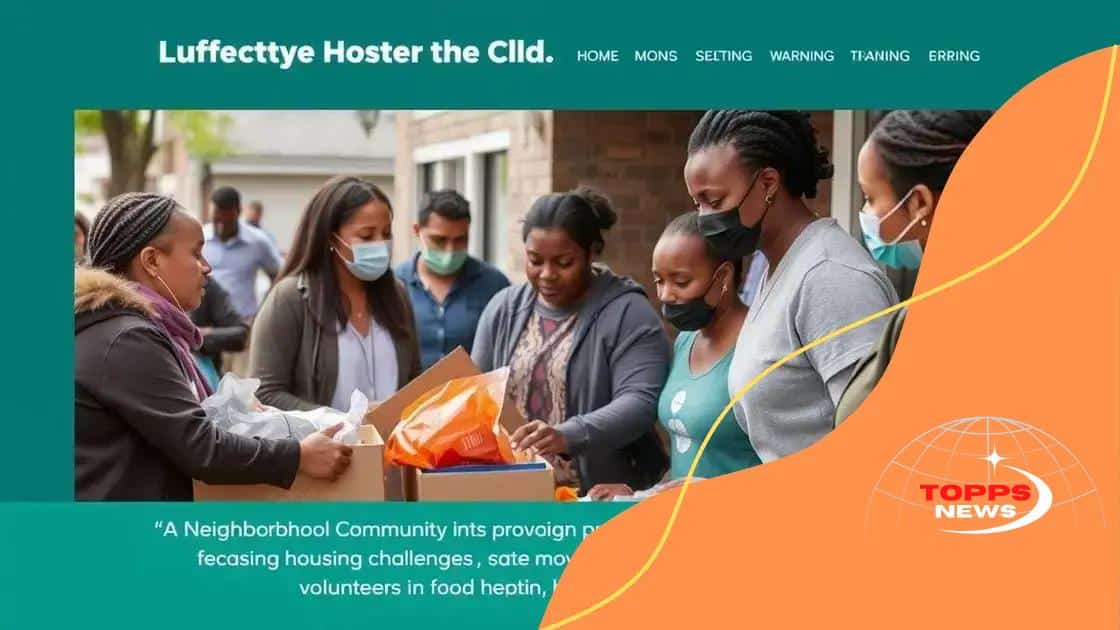Homelessness prevention efforts: strategies that work

Homelessness prevention efforts involve strategies such as financial assistance, access to support services, and community engagement to help individuals and families maintain stable housing and avoid crisis.
Homelessness prevention efforts play a vital role in ensuring that individuals and families don’t fall into crisis. By exploring various strategies and community involvement, we can better understand how to combat this pressing issue. Let’s delve into what truly makes a difference.
Understanding homelessness prevention
Understanding the importance of homelessness prevention is essential for creating stronger communities. When we look at the factors leading to homelessness, we see that early support can significantly impact lives.
What is Homelessness Prevention?
Homelessness prevention includes strategies and services that aim to keep individuals and families housed. By addressing the root causes, we can help those in need before they reach a crisis point. This proactive approach not only saves lives but also reduces strain on local resources.
Key Components of Effective Prevention
- Access to financial assistance to help with rent or utilities.
- Providing counseling services to resolve personal or family issues.
- Connecting families with job training and employment opportunities.
- Offering mental health and addiction services to prevent relapse.
These components work together to form a comprehensive support system. Each element plays a crucial role in ensuring that individuals have the resources needed to maintain stable housing. The combination of assistance and support gives families the best chance of avoiding homelessness.
Community Involvement
Local initiatives are vital in the fight against homelessness. By engaging the community, we can create awareness and promote resources available to those at risk. Collaborative efforts between organizations and volunteers foster a network of support that empowers individuals to seek help.
Education also plays a pivotal role in homelessness prevention. By informing the community about the signs of potential homelessness, we can encourage timely intervention. This awareness not only helps individuals but also strengthens community bonds.
Ultimately, understanding homelessness prevention is about recognizing the shared responsibility we have towards our neighbors. By providing support and resources, we can create a more inclusive society that values every individual’s right to housing.
Key strategies for effective intervention
When discussing key strategies for effective intervention in homelessness prevention, it’s crucial to understand the components that make these strategies successful. By focusing on targeted actions, we can help individuals and families remain housed and secure.
Immediate Financial Assistance
One of the most effective interventions is providing immediate financial aid to those at risk of losing their homes. This assistance can cover rent, utilities, or other essential expenses. By helping with these costs, families can stabilize their situation.
- Emergency rent relief to prevent eviction.
- Utility assistance to keep essential services running.
- Support for unexpected medical or transportation costs.
These resources help in maintaining stability and preventing a slide into homelessness.
Access to Support Services
Beyond financial aid, access to comprehensive services is vital. This includes counseling and support systems that address underlying issues. For example, mental health support and substance abuse counseling can significantly improve a person’s ability to stay housed. Effective intervention requires connecting individuals with the help they need.
Services can also include job training and career counseling. By equipping people with skills, they can improve their job prospects, ultimately leading towards financial independence.
Building Community Networks
Creating a network of support within the community can enhance intervention efforts. This involves engaging local organizations, volunteers, and government agencies to collaborate effectively. When everyone works together, resources can be shared, and outreach can be expanded. A strong community can offer both practical assistance and emotional support.
Engagement can happen through workshops, awareness campaigns, or resource fairs. By fostering a culture of support and understanding, communities can better address the needs of their vulnerable members.
Overall, understanding and implementing these key strategies for effective intervention are crucial in preventing homelessness. By addressing financial needs, providing access to services, and strengthening community ties, we can create a holistic approach that keeps individuals and families safe and secure.
Role of community organizations

The role of community organizations is vital in preventing homelessness. These groups often serve as the first line of support for individuals and families facing housing challenges. Through their efforts, they can create a significant impact on the lives of those at risk.
Providing Local Resources
Community organizations typically offer various resources that help individuals maintain their housing. This can include food pantries, health services, and educational programs. By addressing basic needs, these organizations play a crucial role in stabilizing households.
- Food assistance to relieve financial burdens.
- Access to healthcare for individuals and families.
- Job training programs to enhance employability.
These resources not only assist families in staying housed but also build a foundation for long-term stability.
Building Awareness and Advocacy
Another essential part of community organizations’ roles is to raise awareness about homelessness and advocate for policy changes. They can influence local and state governments to allocate funds and resources to support prevention efforts. By mobilizing community members, these organizations can spotlight issues and create collective action.
Advocacy can lead to better programs and funding aimed at preventing homelessness. Engaging the community through events and campaigns can change public perceptions and promote understanding.
Collaboration with Other Agencies
Community organizations often collaborate with other local agencies, including government services, nonprofits, and faith-based groups. These partnerships enhance the network of support available for individuals in need. When organizations work together, they can share resources, knowledge, and best practices.
Collaboration leads to comprehensive solutions, making it easier for families to access multiple forms of assistance. By fostering strong partnerships, community organizations can better address complex issues surrounding homelessness.
In conclusion, the role of community organizations in homelessness prevention is multifaceted. By providing resources, advocating for change, and collaborating with others, these organizations create powerful support systems that help keep families safe and secure.
Government policies and supports
Government policies play a crucial role in addressing homelessness and ensuring effective prevention strategies are in place. Understanding the various types of support available can empower communities and individuals alike to seek assistance when needed.
Financial Aid Programs
Many government agencies offer financial programs aimed at preventing homelessness. These programs often provide funds for rental assistance, emergency housing, and utility payments. Such help can be lifesaving for families at risk of eviction.
- Housing Choice Vouchers that assist with rent payments.
- Emergency Solutions Grant (ESG) programs for immediate aid.
- Low-Income Home Energy Assistance Program (LIHEAP) for utility costs.
By providing financial assistance, these initiatives help maintain stable housing for vulnerable populations.
Support Services
In addition to financial help, government support often includes essential services like counseling and case management. These services ensure that individuals receive holistic support that addresses their specific needs.
Case management can connect people to vital resources, such as job training, mental health services, and addiction recovery programs. This comprehensive approach empowers individuals to improve their circumstances and maintain stability.
Legislation to Strengthen Protections
Effective legislation is also key in protecting those at risk of homelessness. Laws that prevent unfair evictions and provide rights for renters help create a safer environment for families. Such protections are vital in maintaining housing security.
Additionally, government policies that promote affordable housing development can address the root causes of homelessness. By increasing the availability of low-income housing, communities can support individuals seeking stable living conditions.
Overall, understanding government policies and supports is essential for combatting homelessness. By utilizing available resources, communities can foster stronger safety nets that help prevent individuals and families from falling into housing insecurity.
Measuring success in prevention efforts
Measuring success in prevention efforts for homelessness is essential to understand the effectiveness of strategies used. By tracking outcomes, organizations can evaluate what works and what needs improvement.
Key Performance Indicators (KPIs)
Identifying key performance indicators (KPIs) helps organizations set benchmarks for success. Some commonly used KPIs in homelessness prevention include:
- Reduction in the number of evictions in the community.
- Increases in the number of families that maintain stable housing for 6 months or longer.
- Engagement levels in support programs, such as counseling or job training.
These metrics give organizations a clear view of how well their interventions are working.
Client Feedback and Surveys
Gathering feedback from clients who receive services can provide invaluable insights. Surveys and interviews can help assess how effective support services are in meeting individual needs.
Understanding clients’ perspectives can highlight areas that require attention and improvement. When clients feel heard, organizations can better tailor their programs to serve the community effectively.
Data Analysis for Trends
Analyzing data over time is crucial for identifying trends. By reviewing past data, organizations can forecast future needs and adapt their approaches accordingly. For instance, if a certain type of assistance shows a consistent decrease in homelessness cases, that program can be expanded.
Additionally, studying demographic data allows organizations to pinpoint specific populations that may need more targeted intervention. This proactive approach enhances overall effectiveness.
Ultimately, measuring success in prevention efforts involves a combination of KPIs, client feedback, and data analysis. By continually evaluating strategies, organizations can improve their services and help more individuals find and maintain stable housing.
FAQ – Common Questions about Homelessness Prevention Efforts
What are the main strategies for preventing homelessness?
Key strategies include providing financial assistance, access to supportive services, and community engagement.
How do community organizations help in homelessness prevention?
They offer essential resources, advocate for policy changes, and build networks to support individuals in need.
Why is measuring success important in prevention efforts?
Measuring success helps organizations understand the effectiveness of their strategies and make necessary improvements.
What role does government policy play in homelessness prevention?
Government policies provide funding, protections, and a framework for effective homelessness prevention strategies.





